
Nick MacKinnon is a freelance teacher of Maths, English and Medieval History, and lives above Haworth, in the last inhabited house before Top Withens = Wuthering Heights. In 1992 he founded the successful Campaign to Save Radio 4 Long Wave while in plaster following a rock-climbing accident on Skye. His poem ‘The metric system’ won the 2013 Forward Prize. His topical verse and satire appears in the Spectator, and his puzzles and problems in the Sunday Times and American Mathematical Monthly. Email: nipmackinnon@gmail.com
Guest blog – Walshaw Turbine 21 by Nick MacKinnon
Turbine 21 Fox Hole Hill SD 95165 35492 ///gullible.sculpting.bombshell

This blog examines the finances of Calderdale Wind Farm Ltd, and the venture capital bet they are running on Walshaw Moor.
15 October 2024 Fog everywhere. Fog up the Calder, where it flows among green ings and cattle wades; fog down the Aire, where it rolls defiled among the mills and the waterside pollutions of a great and dirty city. Fog on the Humber marshes, fog on the sandstone heights. Fog hovering in the stalled blades of windfarms; fog drooping on the chill nacelles of turbines. Chance people on the gritstone edges peeping into a nether sky of fog, as if they were up in a balloon, and hanging in the misty clouds.
By appointment, I cross with John Page in the bus turn above Pecket Well to give him the avalanche probe (which he will bury to the 240 cm mark). He has recovered from an operation and looking forward to a long day on the moor with a couple of friends who can have no idea what is entailed in finding the site of T31 on White Hill in poor visibility with this septuagenarian superman. The day before his op he led a rock climb graded HVS, the same grade at which I was almost killed by rockfall in 1992.
An hour later, Ali, Stella and I leave Clough Foot in the direction of Heather Hill, whose massif is the crux of CWF. A gamekeeper emerges from Gorple on a quadbike, towing a trailer of traps like owl boxes. The tracks are busy with the autumn operations of an intensive grouse moor.
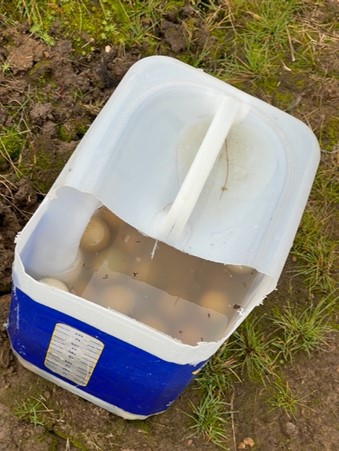
Ali loves Greave Clough, so we stay with it to the footbridge. Here Stella speaks the mantra of fog navigation. “We know where we are now. We won’t if we follow the clough, so we must walk on a bearing.” Normally, you pick a feature, walk to it, and start again. The features today are browner patches of fog. The last resort is to send somebody in front, shout “Left a bit!” as they drift off the bearing and tell them to freeze when they are about to go out of sight.
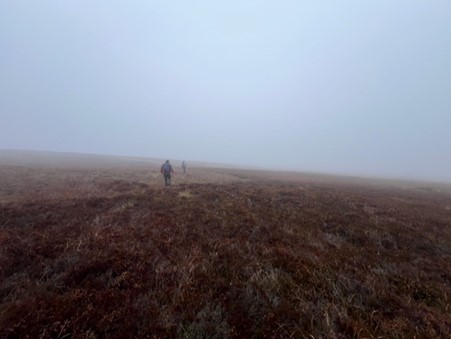
The ground is slashed by deep peat groughs. The peat survey is yellow here, between 1.5 and 2 metres deep, and the head-high walls of the hags confirm this. We land perfectly on the col below the oddly placed T21 on Fox Hole Hill. As you can see on the peat survey, T21 should be moved to the actual summit of Heather Hill: more height, much less peat. North of here, T17 Jackson’s Ridge, T20 Whitewall and T23 Floats are on very deep peat and contorted ground.
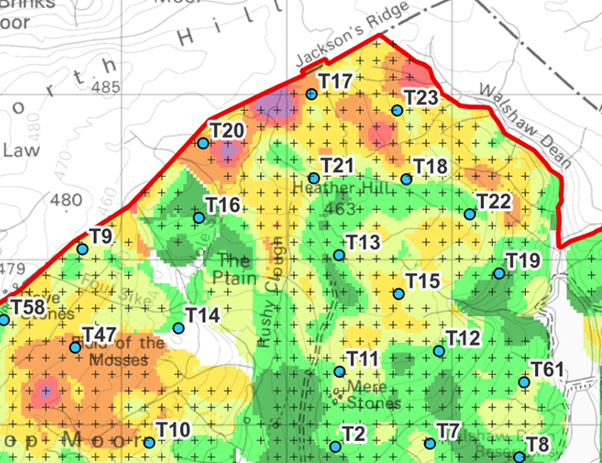
Thanks to Jenny Shepherd, we now know the probing was done in 2022 by TNEI, who produced a useless damson-coloured map using a cheap algorithm IDW (inverse distance weighting) to interpolate between the probed depths. (At any unprobed point X they assigned an average of the twelve nearest probed depths to X, weighted by the inverse squared distance from X). The 2022 map has a bulge on Sun Hill matching the probed points outside the 2023 boundary on the peat map, so we know the two maps use the same data but a different method.
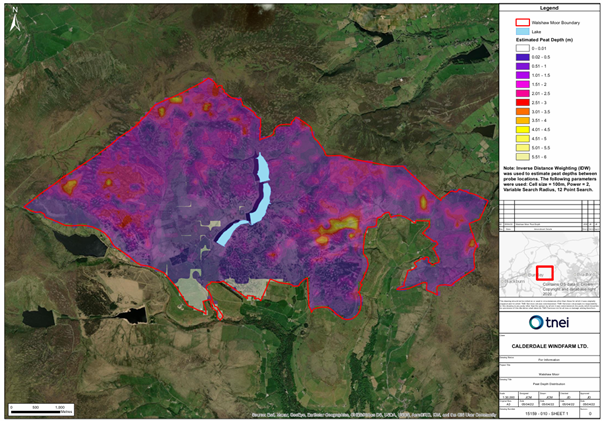
The 2023 map makes better use of the data with an expensive and glorious algorithm (Kriging) developed by Danie Krige to map gold deposits from a few boreholes on the Witwatersrand reef. There are striking blank areas on the 2023 map (west of Greave Clough) where the Kriging has given up because the TNEI data was much too scanty. We can’t use the 2022 map to fill these areas in because the IDW algorithm is hallucinating in the blanks: it has found the 12 closest probed points and averaged them, but they are so far away the result is meaningless.
From the CWF Ltd accounts, we see the probing probably cost £164,000. Christopher Wilson’s carelessness with the last £2000 of expenditure is bizarre. Natural Power should have been sent back for a morning to probe the blank areas west of Greave Clough. For the sake of £2000, what should have been an indication of competence becomes a further demonstration of Wilsonian muddle.
One pathway to a catastrophic flood in the Calder post CWF is the overwhelming of the sluice in Greave Clough that diverts the western catchment’s flow into Widdop Reservoir through a 19th-century tunnel. Catastrophic flooding must be a key aspect of the planning process, but we do not know what the peat is like upstream of the sluice. The description of the role of Worldwide Renewable Energy (WWRE) is “managing the planning and consenting process.” Why did Christopher Wilson accept the failed map in such an important area?
We were going to attempt to find the northern gullet of the reservoirs in Bofts Hole, but the photograph shows me about to funk the navigation, and we head down the easy spine of Heather Hill.
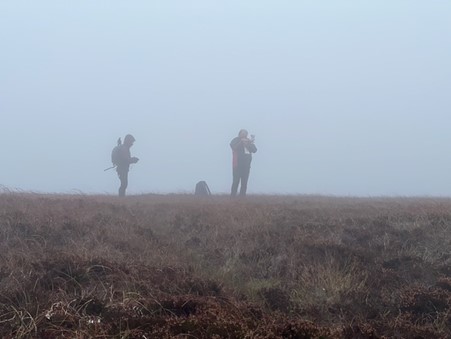
Now we are on the ridge, the ground is easy. This is the way the blades would come up Heather Hill, but I think the CWF track would stay on the ridge rather than running steep spurs off the Bannister track, because the spurs would become storm drains in a downpour. We watch a gamekeeper gun his quadbike and make a direct Evel Knieval ascent up to Mere Stones. We halt our frail, travelling bubble of visibility for some lunch. Ali has either not brought an egg in solidarity with the doomed stoats or eats it under cover of the fog. Stella points to the sycamores that mark the site of one of the lost farms, whose cattle were thought to be a TB threat to the reservoirs. She says the left one is “crownshy” and there was once a second tree. Crownshy is one of those perfect words that makes you see better.
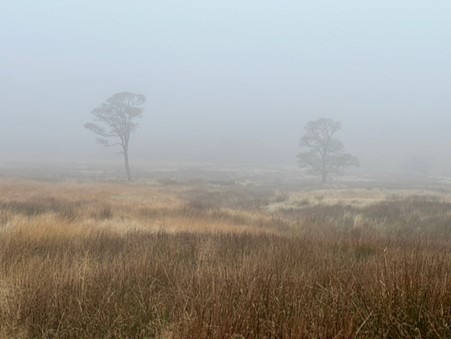
Over lunch it emerges that Stella read History at Oxford, where she met Ali who was reading Psychology. Afterwards, while Ali was working as a piano tuner in a factory, and playing nights in an all-girl rock band, Stella was saving terraced housing in Liverpool. Many councils demolished their slums in swathes and rehoused their tenants in high rise blocks: Glasgow’s destruction of the Gorbals is a case study in nightmare. Stella and her friends (“Three can-do young men in the Liverpool Corporation, the Housing Corporation and the Housing Associations who were good drinking pals too”) decanted people from slum streets into nearby refurbished terraces so that the renovation programme could continue to roll. Saving the Victorian terraces is the most visionary housing policy of the last 50 years, a major contribution to happiness and the capital stock of the UK, and a huge saving in embedded carbon. “I keep meaning to go back to see what those streets are like now.” The Welsh Streets (which include Ringo Starr’s birthplace) became the focus of an intense standoff in 2014 that prefigures CWF. The Planning Inspectorate agreed that Liverpool council could demolish. Secretary of State Eric Pickles overruled the Inspectorate in favour of refurbishment, and five years later the Welsh Streets were named top residential scheme at the 2019 national final of the Royal Institution of Chartered Surveyors awards. When the Planning Inspectorate reject CWF, Ed Miliband will have the same power to overrule. Christopher Wilson’s bet hinges on his using that power, once used so well by Eric Pickles, who was born in Keighley.
I’m struck by Ali and Stella’s response to the 1970s zeitgeist and how quickly it changed. In 1982 my friend who had read Chemistry landed three job offers.
1] Making soap at Grays on the Thames estuary for £7200 p.a.
2] Making radioisotopes at Harwell for £7400 p.a.
3] Trading bonds at Bank of America for £100,000 p.a.
We are in the era of vampire capitalism, of which that base salary (the bonuses made it look tiny) was a stark signal. CWF is not about climate change. It is a venture capital bet on the personality of the Secretary of State at the Department for Energy Security and Net Zero (DESNZ). A symptom of our demoralisation is that we cannot finance the renewal of our electricity supply and find ourselves bystanders at this lottery. In the 1950s a much poorer country, recently smashed up by the Luftwaffe, could afford the deep knowledge of the engineers running the Central Electricity Generating Board.
When built, CWF will be sold to a pension fund who want the almost riskless income generated by the strike price for 15 years. The externalities are all on us: we must finance the Contract for Difference; we pay for new transmission to random substations determined by landowners; we cover the backup generation for prolonged periods of overcast stillness like the last fortnight; we set aside annual sums for the increased flood risk; we pay for the storage solutions to intermittency. The easy bit is sticking up the turbines on top of the curlews. Privatise the profits: socialise the costs. We should sometimes think about how strange this is.
There are three phases of financial engineering involved in the building of CWF. Phase 1 is the consent gamble. Phase 2 is the construction. Phase 3 is the generation. I shall look at the economics of Phase 2 and Phase 3 in later blogs.
Phase 1: a £12 million bet on the apparent bullishness of Ed Miliband
CWF is wholly inside, and would annihilate by fragmentation, a Special Protection Area (SPA) and Special Area of Conservation (SAC); and destroy by precedent those two cornerstones of UK habitat policy that remain integrated with European law. A developer with a reputation to lose would not touch it. That makes it an opportunity for a developer with no track record. In a gold rush, beggars can’t be choosers.

Three powers (302 MW, 240 MW and 170 MW) have been announced by WWRE in various ways. To understand the venture capital lottery, we need to put some probabilities and prizes on these wind farms.
302 MW CWF is unlikely
I don’t know anyone who thinks 302 MW CWF is likely to get consent, and that includes, to judge by their own announcements, the developers and, as far as one can tell, even Richard Bannister.
- CWF at all sizes is on an SPA and SAC which are part of international legal agreements about wildlife and habitat. The precise way the law is phrased is given below. DESNZ will be subject to judicial review if they pass any development in the SPA/SAC, but WWRE may imagine the department’s lawyers can tell the court some kind of story (crafted by WWRE) about a 170 MW CWF. There is no room for a story at 302 MW and defeat by the judges would cast a shadow over the whole Labour administration and the Net Zero project.
- Even an expert enthusiast for wind, who has told me that I should not be campaigning against CWF, calculates that CO2 emissions of 302 MW CWF make it ‘marginal’ so that it might not repay its carbon debt. They say that it should be ‘pulled back from the deep peat,’ and the model they have in mind is 170 MW. This expert had not understood the SPA/SAC legal position when we had our long conversation in a café in Todmorden: “I’m not a birder”. With this contemptuous phrase, they showed why we must campaign against CWF.
- CWF Ltd have been accepted for up to 240 MW at Rochdale DNO. They entered 240 MW into the Embedded Capacity Register and gave the position of an offsite substation at Shackleton. All the evidence is that connection to the National Grid for 302 MW will be long-delayed. Up to 240 MW at Rochdale is as near to a bird in the hand as the transmission system offers.
- 240 MW CWF would be 52 turbines which means the 13 turbines west of Greave Clough would not be built. The land west of Greave Clough is far more controversial: the peat is deep (5.2 metres has recently been found at T5); the landscape is more charismatic (along the Scout and at Dove Stones for example) and less spoiled by tracks; the deep peat makes the engineering more expensive and riskier.
- The peat survey contains blank sections west of Greave Clough. Christopher Wilson should not have accepted such a deficient survey had this land mattered to the application.
- It is very difficult to draw a convincing track system for the layout west of Greave Clough because the peat is so deep, the land is so wet, and the survey is incomplete. Whatever system is chosen involves contour-crossing tracks that will act as storm drains. The peat survey is inevitably less accurate on the deeper peat. It is easy to survey the dark green peat; the probe barely goes in. West of Greave Clough is terra incognita in engineering terms.
- CWF at all sizes will increase the flood risk in Hebden Bridge and down the Calder valley. In a stationary rainstorm, concrete, impacted aggregate and ditches on a saturated slope west of Greave Clough seem certain to accelerate the surface flow and overwhelm the sluice and tunnel to Widdop reservoir, causing the overflow pulse to travel directly to Hebden Bridge.
- 302 MW and 240 MW CWF destroy the internationally famous Brontë landscape, but this destruction is less at 170 MW.
- Richard Bannister has allegedly told the gamekeepers that there will be “more work for you” after the wind farm is built. Where is the work at 302 MW?
- WWRE’s doubts about 302 MW CWF are evidenced by their announcement of a 170 MW fallback in the revised FAQ 17 in the month before they wisely jet washed their website of their abjectly incompetent, and in places cringeworthy, FAQs.
- Cynics say, “Developers always add 50% to what they actually want so the planners can knock it off again and everyone looks good, including the campaigners.”
Maps of 240 MW and 170 MW CWF


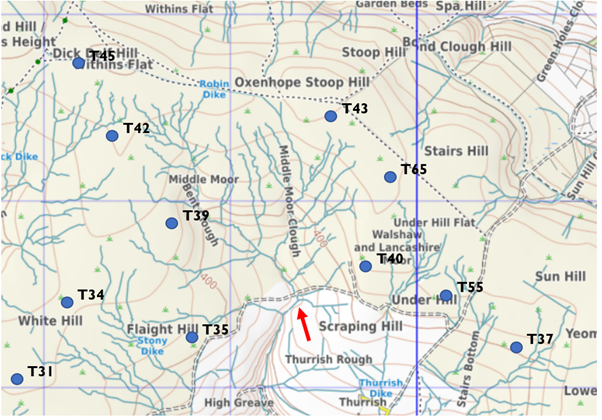
Dramatis personae
Christopher Wilson is the founder of Calderdale Wind Farm. He resigned in favour of Dr Ghazi Mohammed Ahmed Osman who is the sole director. Mr Wilson is now Executive Chairman. There are no employees. Everyone who works for CWF Ltd is paid as a consultant. The landowner of Walshaw Moor is Richard Bannister. The CWF accounts for 2022 and 2023 accounts are available at Companies House.
Follow the money
The method in Phase 1 is that CWF Ltd pays Richard Bannister an annual sum and in return he must sell the land to CWF Ltd for an agreed price if consent is gained. At that point CWF Ltd will own an asset which they could sell to another developer, or more likely develop themselves in Phase 2. The numbers below are taken from the published accounts for 2022 and 2023.

The difference between Dr Osman’s £7,225,851 and the obvious spending of £5,033,664 is £2,192,187 and most of this is unspent “Shareholder’s funds” of £1,622,235 and £247,073 of cash in the bank. The residue of £322,879 is under “Other debtors” that I don’t know how to attribute.
The administrative expenses are broken down. The big ones are:

The bird surveys are appended to the Scoping Report and undertaken by Keystone Ecology. The layout plan, the peat depth map and the bat work were done by Natural Power who wrote the Scoping Report so might come under Consultancy fees rather than Survey costs in the 2023 account. The 2022 survey figure must include the peat probing done by TNEI, which may account for the whole sum of £163, 970.
Although a single employee is mentioned in February 2022, in the more comprehensive 2023 accounts there are no employees, so Executive Chairman Christopher Wilson must be paid as a consultant, like everybody else doing work for CWF Ltd. The money spent on consultancy fees in 2022 and 2023 must be mostly to Mr Wilson and Natural Power who compiled the Scoping Report.
How much for the land?
Of the £5,033,664 obvious spending, £3,882,150 has gone to Richard Bannister. So far, he has had £1651 per ha for the 2352 ha site. For comparison, 497 ha Bannock Hill grouse moor at Fettercairn in Kincardineshire recently sold for offers over £235,000 or £473 per ha. The 121 ha allotment on Horden Moor in the AONB in Teesdale was guided at £750,000 or £6200 per ha. Priorsdale Moor in Cumbria at 1700 ha was guided at £4.75 million or £2800 per ha. Estate agent GSC Gray’s 2021 figures for this kind of land are £3700 per ha for moorland and £7400 per ha for rough grazing, and in the Dales and North Pennines these high values are underpinned by purchasers who intend to obtain consent to plant trees in carbon offset schemes. These schemes will destroy the breeding grounds of the curlews, lapwings, and golden plovers. The more trees we plant on the high ground, the more important the protected South Pennines SPA is to the ground nesting waders.
To build our model, we need a figure for Richard Bannister’s price. I think the strange sum of £2,632,150 paid in 2023 represents 10% of the agreed price of £26,321,500, which values the CWF land at £11,200 per hectare. I don’t think it can be 5% (£13 million) or 20% (£53 million). £11,200 gives Mr Bannister some of the planning upside. A grouse moor’s value is underpinned by the number of grouse shot, at about £6000 per brace in the five-year average, and on its ability to attract tax-payer’s money for “conservation work”. Driven grouse shooting distorts UK nature policy and Wild Justice have a parliamentary petition to ban it. Grouse moor owners will certainly give up if they can get £11,200 per ha for watershed bog in an undevelopable Special Protection Area.
If an application for planning permission by Direct Consent Order via the Planning Inspectorate is made in Spring 2025 (which is what the website now claims) some of what has been spent on the FAQs-18 “Summer 2024” Calderdale Council application can be recycled. The appendix on Grade II listed houses and the peat survey, if properly finished, would feature in the planning application. Perhaps the bird work that the RSPB said was inadequate will be proffered to the Inspectorate. Most of the money spent on administration in 2022-24 is a dead loss for Dr Osman following the U-turn on 18 October. It looks like he has 2024 and 2025 to pay for at much the same rate as 2023, and that CWF Ltd might get to the point of an application having spent about £12 million, of which Richard Bannister will have had £9 million (£9,146,450) at £3889 per ha. I am almost sure the options payments are also non-refundable instalments, otherwise Richard Bannister is getting far too good a deal. The purchasers will surely have to buy the whole site even if the permitted layout is smaller, so the land becomes very expensive at 170 MW. All this expenditure is normal for a wind farm, except that Walshaw Moor is an SPA and SAC, so the Planning Inspectorate must reject, just as Calderdale would have done. The rejection grounds will be national and international law: there will be nothing nimby about it. The plan depends on what happens after the rejection.
The prizes
We can now see the outlines of the bet being made by CWF Ltd on consent, which is Phase 1 of the development.
Win the whole 302 MW: pay the extra to buy CWF so total expenditure is £29 million. Sell the site to Phase 2 of CWF for (say) £70 million, a £41 million profit. Dr Osman may be a buyer at that price. Christopher Wilson walks away with quite a big slice of that profit as a minority shareholder. He resigns as Executive Chairman because Phase 2 calls for an engineering skillset which he manifestly does not have. Until quite recently his company was telling the people of Calderdale that the National Grid ran at 440 Kelvin Volts and his wind farm was accepted to connect at Padiham.
The bet will also pay out at 240 MW and 170 MW. The land is proportionately less valuable if it hosts a smaller wind farm. The expensive connection to Rochdale weighs more heavily at 170 MW and Christopher Wilson has said that CWF is not economic below 200 MW, while also announcing 170 MW as an option in one of his FAQs. He isn’t good at maintaining a narrative. We will try to model that effect in the blog on Phase 2.
Win at 240 MW: pay the extra to buy CWF so total expenditure is £29 million. Sell the site to Phase 2 of CWF for £56 million, a £27 million profit.
Win at 170 MW: pay the extra to buy CWF so total expenditure is £29 million. Sell the site to Phase 2 of CWF for £39 million, a £10 million profit which may be reduced by other factors.
Lose: £12 million is lost, mostly to Richard Bannister.
Expectation
‘Expectation’ is what you stand to win on average. If you buy a Lucky Dip Lotto ticket for £2 your expectation is £1.06 because they pay out 53% of the total staked in prizes. Most of that £1.06 expectation is in enormous prizes at tiny probability. Some number combinations have a better expectation and others a lot worse. The very worst is 1, 2, 3, 4, 5, 6, chosen weekly by over 7000 players who can win at most £2000. Every combination is equally likely to win, but what you win depends on how many others have your numbers. In the 9th draw on 14th January 1995 the balls were 7, 17, 23, 32, 38, 42 and an astonishing 133 people had chosen all six, each winning a paltry £122, 510. The tickets then cost £1 and the expectation of 7, 17, 23, 32, 38, 42 before the draw was just 18p, of which 17p was the expectation of the fixed £10 prize for a 3-ball match, which every combination enjoyed. After the draw, the ticket was worth £122,510.
A contact I shall call ‘Southampton’ used the mathematics of heat distribution to determine the valuable number combinations that the players were avoiding. By the astonishing and sinister unity of mathematics, the method is the same as Kriging the peat survey. The punters are spread like peat at unknown depths on top of a landscape of number combinations. Each draw is like a peat probe, with the number of winners in the five prize tiers revealing the depth of the punters at, and near, that week’s chosen combination. After a year of draws, Southampton knew what the most probable punter depth was over the whole landscape of 14 million possible tickets and would give you a valuable zero-depth combination if you asked nicely. Eventually people learned to play better and spread out, (‘entropy increased’ is how Southampton put it) rollovers and excitement diminished and they had to put more balls in the machine. This trajectory is universal in lotteries. Normal lottery players do not have a venture capital mindset at the start, and some never acquire it, but most understand this aspect over time. “Don’t use your grandchildren’s birthdays!”
Most of us do not have the venture capital mindset either, which is that expectation is real money and you can buy it much more cheaply at low probability. I was a backgammon champion but I had to be taught a lesson in expectation at low probabilities by Francis Maude. I asked him if he was sorry not to have been Prime Minister. “I had a 4% chance, and you, Nick, had a 0% chance. Although 4% and 0% seem rather similar, I get to be Prime Minister every 25 lifetimes but you will never be Prime Minister.”
Probability and expectation on Walshaw Moor
Christopher Wilson said at the Hilltop Parishes meeting in December 2023 that he thought probability of consent was now 80%. To understand the venture capital mindset of Christopher Wilson, put yourself in his brogues in 2022 and use the following exuberant probabilities, each conditional on the previous event. I’m not saying they’re right: we’re trying to understand the oppo. Mr Wilson only had to convince one person, Dr Osman, that there was something here.
Labour win: 90%. Miliband to DESNZ: 90%.
302 MW 20%, 240 MW 40%, 170 MW 20%, 0 MW 20%.
The expectation is £ 0.9×0.9×(0.2×41 + 0.4×27 + 0.2×10) million = £17 million
If you believe those probabilities, or something like them, and have the venture capital mindset, to pay only £12 million for something worth £17 million is excellent business.
There were other ways to win in 2022. Liz Truss wanted to deregulate onshore wind and would have been gung-ho with the SPA; Rishi Sunak and Michael Gove were edging that way; other Labour DESNZ ministers might have offered Mr Wilson a non-zero spread of probabilities. These outcomes only add a little to the expectation because they happen in the 19% space where Labour doesn’t win or Ed Miliband isn’t at DESNZ.
The 2022 expectation of £17 million increased to £21 million in 2024. Events have cancelled the two factors of 90% because we do have a Labour government, Ed Miliband is at DESNZ, and he has even made a keynote speech “Every turbine we put up …” confirming Mr Wilson’s exuberant assessment of the probabilities, which we still think are wrong, because we’ve read the habitat regulations. Remember that Christopher Wilson hadn’t even read the Aggregate Assessments.
The distribution of Christopher Wilson’s “80% probability of consent” between the three powers makes a lot of difference to the expectation.

It is not a nice thing for a Labour Party member to say, but Phase 1 of CWF is £12 million of Lottery tickets bought by someone who has worked backwards from a scenario in which Ed Miliband overrides UK and European law, dismantles the SAC/SPA backbones of habitat and wildlife conservation, and faces down the judges. WWRE think they have great numbers and they also know the judicial review is not their problem. Mr Miliband’s lawyers will be advancing a story about the South Pennine Special Protection Area crafted for them by WWRE, and we will all be paying for those DESNZ lawyers to present it.
One reason I campaign against CWF right now is to stop Walshaw Moor and its curlews being used as a venture capital lottery, our Secretary of State being modelled as a stooge and our government’s lawyers having to be sock puppets for some WWRE fairy tale about the South Pennine SPA. These are things that only happen in a demoralised society. We put Walshaw Moor beyond Christopher Wilson’s reach when we still had confidence in ourselves.
Beyond reach? The habitat laws
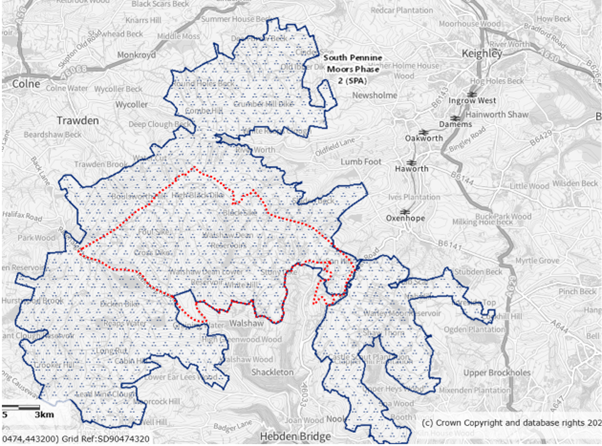
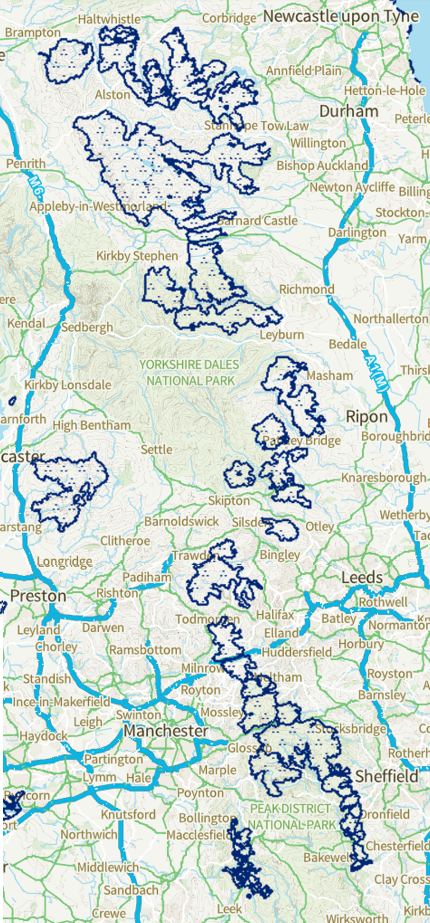
To build CWF on the internationally designated South Pennines SPA and SAC, a habitat derogation must be obtained, because CWF inevitably fails the integrity test. Here is the law according to the Government’s own website.
Habitats regulations assessments: protecting a European site
“How a competent authority must decide if a plan or project proposal that affects a European site can go ahead. Last updated December 2023.
If the proposal fails the integrity test because you cannot rule out an adverse effect on site integrity, you must reject the proposal in its current form. This means permission is not granted. The work cannot go ahead or the plan cannot be adopted unless it can pass three legal tests and be granted an exception, known as a derogation. To decide if the proposal qualifies for a derogation, you must apply the three legal tests in the following order:
1] There are no feasible alternative solutions that would be less damaging or avoid damage to the site.
2] The proposal needs to be carried out for imperative reasons of overriding public interest.
3] The necessary compensatory measures can be secured.”
If the matter comes to judicial review the following three points will be made.
1] There are thousands of feasible alternative sites for wind farms that are not protected by law, and these have been mapped by Friends of the Earth.
2] The need for 302 MW is neither imperative nor overriding if 15000 MW is being built onshore and 45000 MW offshore.
3] The compensation cannot be secured on site, because the whole site is already an SPA.
It will also be put to the court that if this wind farm is allowed on Walshaw Moor, then the whole Pennine SPA will be developed on the precedent. The legal framework of UK habitat law, which is integrated with European law because wildlife conservation cannot be carried out in one country, is destroyed by CWF.
In these blogs, stretching back to T2 Mere Stones, we have examined obstacles to CWF. They include the difficulties for blade access by public roads; the unsuitable onsite rock for roadstone and concrete; the problems of connection; the CO2 intensity; flooding in Hebden Bridge; the Brontë heritage; the close-packed streets of Oxenhope and Hebden Bridge; the inexperience of the Executive Chairman; and now the venture capital bet into which the other difficulties feed. All these factors are part of the mosaic of reasons not to build CWF if you are the Money or the Planning Inspectorate, but none of them seems to be an insuperable obstacle.
The remaining obstacle is that CWF is a shattering illegal intrusion into an SPA and SAC, the breeding ground of lapwings, golden plovers and curlews, and a habitat that has taken thousands of years to develop, and would be a precedent for a wind farm on every SAC and SPA in the Pennines. Dr Osman and Mr Wilson have a £12 million bet on being allowed to bulldoze Walshaw Moor and the law. Richard Bannister, who owns the lottery, will make many millions out of their gamble either way.
++++++++++++++++++++++++++++++++++++++++++++
This is the 24th in a series of 65 guest blogs on each of the wind turbines which Richard Bannister plans to have erected on Walshaw Moor. Turbines 5, 6, 8, 9, 11, 17, 25, 27, 31, 32, 33, 34, 35, 40, 43, 44, 47, 54, 56, 58, 62, 64 and 65 have already been described. To see all the blogs – click here.
[registration_form]
What an interesting blog post. My head is spinning. Good luck.
On another matter, where can I read The Metric System? A web search found a few pages with just the beginning.
Thank you Sarah. If you drop me an email at nipmackinnon@gmail.com I will send you The Metric System. It was printed in the Independent when it was still a newspaper and you might get it there too, if you can fight your way past the click-bait.
Now, would you like to do a turbine blog? Nick
There’s a Bullion Clough on them there moors.
I’ve just cross-checked https://streetmap.co.uk/map?x=394777&y=435489&z=115&sv=394777,435489&st=4&ar=y&mapp=map&searchp=ids&dn=517&ax=394777&ay=435489&lm=0
with my laminated paper copy of ODL 21 (dated back to ~ a decade, or quite possibly more).
Bullion Clough, Bullion Hill and Green Bullion.
Brilliant blog. Thank you so much Nick Mackinnon. Had me re-reading the opening paragraphs of Bleak House again a few decades since the last time I read them!.
Amongst a lot of humour and acerbic wit, you make what was, for me, the very serious point that we are now such a demoralised country, we’ve given up trying to finance stuff properly – leaving ourselves – and the curlew – at the whim of venture capitalists and a potentially gung-ho Secretary of State.
Fascinating and yet a touch depressing Nick, the whole ‘gamble’ is now experiencing lengthening odds……
Brilliant work!
This is a fascinating and important blog as ever Nick. I am replying in lawyer mode. you will know most of this but it gives a true sense of urgency.
Ed Millibands scheme to shortcircuit opposition to his overarching Net Zero/Clean Energy Master Plan has a crucial starting point which would be in this case his designation of the CWF as a “Nationally Significant Infrastructure Project” (NSIP).
Classification as an NSIP as you will know circumvents all local opposition and rests the decision entirely with the SoS.
It must be JR’d within 6 weeks of the classification being made public.
Miliband is looking at ways of both limiting the scope and shortening the length of JR via a process underway called ironically “The Banner Review” after Lord Banner KC. This proposes curtailing “bites at the cherry” in terms of objection and a statutory framework of time limits that will hamper all but the best organised opposition.
I suspect the major debate going on within Milibands Empire is just when to fire this pistol and start classifying schemes as NSIP’s and sequencing it with the “Banner Reforms” to streamline JR.
Given that the driving imperative of Miliband is his apparently sincere belief in the imminent collapse of the ecosphere we really need to anticipate the 6 week time limit being triggered suddenly and it would be a very good idea to prepare for JR using all the brilliant work you have done within the challenging legal framework where the opposition will be ferociously well resourced ie the State.
I strongly suspect they key decision for all of these proposals will be a Supreme Court Hearing probably next year (!) about the reasonableness of the “Banner Reforms” (if any) and the juridicability of the decision to designate a specific Wind Farm Proposal as a NSIP given the classic JR considerations of Impact and Public and “Legal” Interest.
I cannot imagine a more perfect lead case than this one and ducks need to be assembled in suitable rows. With potentially a 6 week lead time.